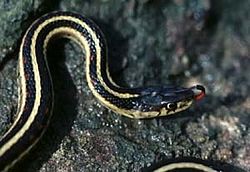Common garter snake
| Common Garter Snake | ||||||||||||||
|---|---|---|---|---|---|---|---|---|---|---|---|---|---|---|
 A Red-sided Garter Snake Thamnophis sirtalis parietalis | ||||||||||||||
| ||||||||||||||
| Binomial name | ||||||||||||||
Linnaeus 1758 |
The Common Garter Snake (Thamnophis sirtalis Linnaeus 1758) is, as the name suggests, quite common in North America. T.s. parietalis has also been introduced to northern Halland in Sweden, where it thrives. The habitat of these snakes can range from forests, fields and prairies to streams, wetlands, marshes and ponds, but they're often found near water. They're semi-aquatic animals that can swim. Habitats range from sea level to montane locations. Their diet consists of amphibians, insects, fish, and rodents. Most garter snakes have a pattern of yellow stripes on a brown background and their average length is about 1 - 1.5 m (3 - 4.5 ft). Like any other snake, garter snakes use their tongue to smell.
Water contamination, urban expansion, and residential and industrial development are all threats to the garter snake’s species. The San Francisco Garter Snake (T.s. tetrataenia), which is extremely scarce and occurs only in the vicinity of ponds and reservoirs in San Mateo County, California, is listed as an endangered species by the U.S. Fish and Wildlife Service since 1967.
Life history
The Common Garter Snake is a diurnal snake. In summer, it is most active in the morning and late afternoon; in cooler seasons or climates, it restricts its activity to the warm afternoons.
In southern, warm areas, the Common Garter Snake is active year-round; otherwise, it hibernates in common dens, sometimes in great numbers. On warm winter afternoons, some Common Garter Snakes have been observed to emerge from their hibernacula to bask in the sun.
Garter snakes generally mate in March or April - after hibernation. The species is viviparous; females give birth to a litter of 12-40 live young anytime from July through October.
Toxicity
The saliva of a garter snake may be toxic to amphibians and other small animals. For humans, a bite is not dangerous, but may produce a swelling or a burning rash. Most garter snakes also secrete a foul-smelling fluid from postanal glands when handled or harmed. Like any predator they are highly unpredictable.
Taxonomy
Current scientific classification recognizes twelve subspecies:
- T.s. sirtalis Linnaeus 1758: Common Garter Snake
- T.s. parietalis Say 1823: Red-sided Garter Snake
- T.s. infernalis Blainville 1835: California Red-sided Garter Snake
- T.s. concinnus Hallowell 1852:Red-spotted Garter Snake
- T.s. dorsalis Baird and Girard 1853: New Mexico Garter Snake
- T.s. pickeringii Baird and Girard 1853: Puget Sound Garter Snake
- T.s. tetrataenia Cope 1875: San Francisco Garter Snake; endangered
- T.s. semifasciatus Cope 1892: Chicago Garter Snake
- T.s. pallidulus Allen 1899: Maritime Garter Snake
- T.s. annectens Brown 1950: Texas Garter Snake
- T.s. fitchi Fox 1951: Valley Garter Snake
- T.s. similis Rossman 1965: Blue-striped Garter Snake
External link
- Description from the California Department of Fish and Game.